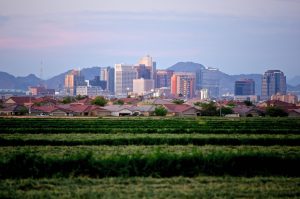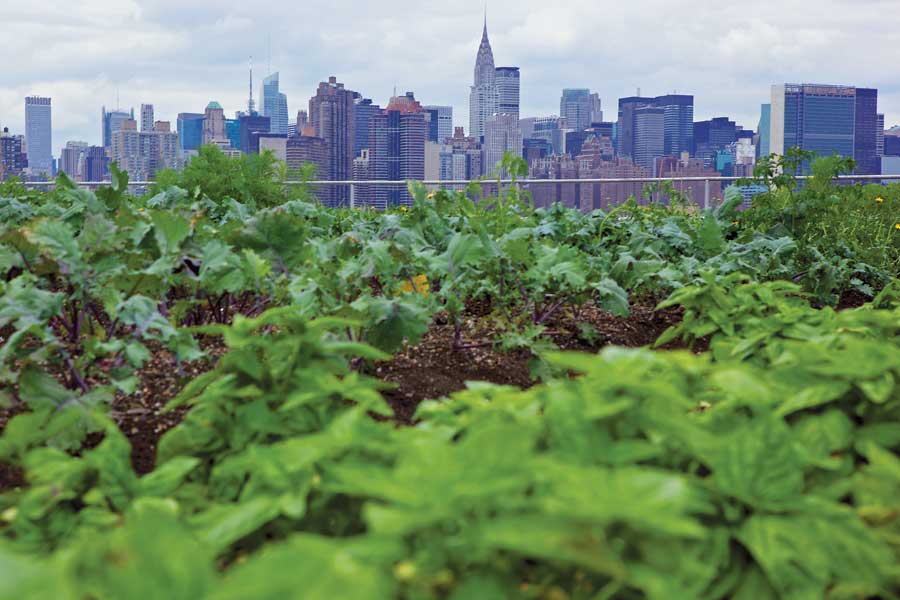As the climate crisis makes its way into more and more headlines and also into the collective consciousness, many cities in the US have begun the push towards the goal of sustainability. This is especially significant given that by 2050, 68% of the world’s population will call themselves city-dwellers, and that cities are responsible for a significant amount of resource use and carbon emissions. Many of the plans and pledges these cities create in the name of sustainability are ambitious and can often seem unrealistic. But researchers in Phoenix, AZ have recently published a study that suggests agriculture may be the key to reaching urban sustainability goals. That’s right, folks, agriculture doesn’t just happen in places like the ones you see out the window of your station wagon as you head out of town on the family camping trip you dread every year. It can happen in cities, backyards, and as these researchers discovered, in previously underutilized city spaces that are often overlooked. Phoenix, like many other cities, has a set of 2050 Sustainability Goals. Researchers have found that if the city maximizes its capacity for urban agriculture, some of the city’s major sustainability goals like the elimination of food deserts, access to green space, and reductions in energy use and carbon emissions can all be reached.
This conclusion was reached by combining these city-specific goals with analysis of detailed data. Three types of urban infrastructure were considered as potential spaces for urban agriculture: vacant lots, flat rooftops, and building facades, all of which make up about 7.1% of the land area in Phoenix. What’s great about this is that these spaces aren’t normally utilized, and therefore urban agriculture hubs wouldn’t be replacing anything, but enhancing something that already exists. It was found that if all these spaces were used to grow food, 183,000 tons of food per year could be produced. Better yet, these urban farms would also be providing local, fresh food to all of the food deserts (areas where many residents do not have a car and where a grocery store selling healthy foods is more than a mile away) in the city.
Researchers found that urban agriculture would not only help eliminate food deserts, but would also provide green space for many communities that don’t currently have access to it. It was discovered that block groups in Phoenix that do not have a park or green space access would drop dramatically from 78% to 31% with the addition of urban farms. In terms of electricity consumption and carbon emissions, researchers found that by growing food on city rooftops, buildings would be better insulated and would need to use less

A view of downtown Phoenix, AZ, where researchers have identified vacant lots, rooftops, and building facades as potential sites for urban agriculture.
Photo by Stephen Zank, licensed under CC BY-SA 2.0
electricity, therefore also decreasing their carbon footprint.
If you’re worried about how all of these fruits and vegetables are going to be watered in a desert city, don’t be too concerned. Agriculture offers lots of opportunities to use recycled water, and the estimated water consumption of urban agriculture in Phoenix was similar to the amount people already use for their lawns and swimming pools. If city residents used that water instead to grow food, the city would still be consuming a similar amount of the precious
resource. Researchers found that a bigger constraint for urban agriculture is city zoning, the price of land, and land ownership versus public ownership.
This research suggests that cities around the country, and the world really, should consider how urban agriculture can be fully utilized in city spaces, and what kind of environmental as well as social benefits residents can enjoy if urban spaces are used to grow more food.
Journal Article:
Aragon, N.U., Stuhlmacher, M., Jordan, P.S., Clinton, N., and Georgescu, M. 2019. Urban agricultures bounty: contributions to Phoenix’s sustainability goals. Environmental Research Letters 14(10).

Alex
"This title was very eye catching! That is so interesting that such a ..."
Alex
"This is really interesting! The fact that crops and plants are damaged is ..."
Alex
"Well done, this article is great and the information is very captivating! Ethics ..."
Alex
"I was intrigued throughout the whole article! This is such an interesting topic, ..."
Alex
"This is such an interesting article, and very relevant!! Great job at explaining ..."
Grandpa
"Honey You Did a good job I will forward to my eye doctor "
murphymv
"This article is fascinating because it delves into the details of the research ..."
murphymv
"I agree, adding the photo helped solidify the main finding. "
murphymv
"This is a fascinating finding. I hope this innovative approach to improving transplants ..."
Sherzilla
"This is a great article! I would really love to hear how exactly ..."
Sherzilla
"It's disappointment that these treatments were not very effective but hopefully other researchers ..."
Sherzilla
"I agree with your idea that we need to shift our focus to ..."
Sherzilla
"It's amazing to see how such an everyday household product such as ..."
Lauren Kageler
"I will be interested to see what the data looks like from the ..."
Lauren Kageler
"A very interesting article that emphasizes one of the many benefits that the ..."
maricha
"Great post! I had known about the plight of Little Browns, but I ..."
Sherzilla
"I assumed cancer patients were more at risk to the virus but I ..."
Sherzilla
"Great article! It sheds light on a topic that everyone is curious about. ..."
maricha
"This article is full of really important and relevant information! I really liked ..."
maricha
"Definitely a very newsworthy article! Nice job explaining the structure of the virus ..."
maricha
"It's interesting to think that humans aren't only species dealing with the global ..."
murphymv
"This is very interesting and well explained. I am not too familiar with ..."
Lauren Kageler
"Great article! This post is sure to be a useful resource for any ..."
Lauren Kageler
"Definitely seems like an odd pairing at first, but any step forward in ..."
murphymv
"What an interesting article! As you say, height and dementia seem unrelated at ..."
murphymv
"Great article! I learned several new methods of wildlife tracking. This seems like ..."
murphymv
"Very interesting topic! You explained cascade testing and its importance very well. I ..."
Alex
"This article is really interesting! What got me hooked right away was the ..."
Sabrina
"I found this article super interesting! It’s crazy how everyday products can cause ..."
Erin Heeschen
"I love the layout of this article; it's very eyecatching! The advancements of prosthetics ..."
murphymv
"Awesome article! I like the personality in the writing. Flash Graphene not only ..."
murphymv
"Very interesting work! I don't know a whole lot about genetics, but this ..."
Cami Meckley
"I think the idea of using virtual reality technology to better help prepare ..."
Erin Heeschen
"I wonder if there's a connection between tourist season and wildfires in the ..."
Ralph berezan
"Not bad Good work "
Michelle
"This sounds like it would be a great tool for medical students! ..."